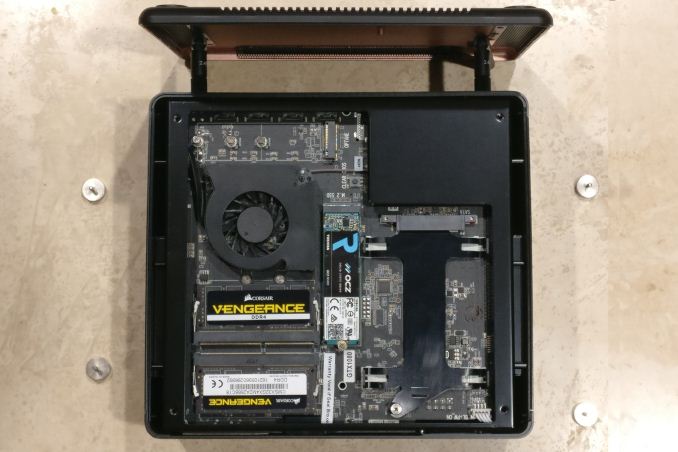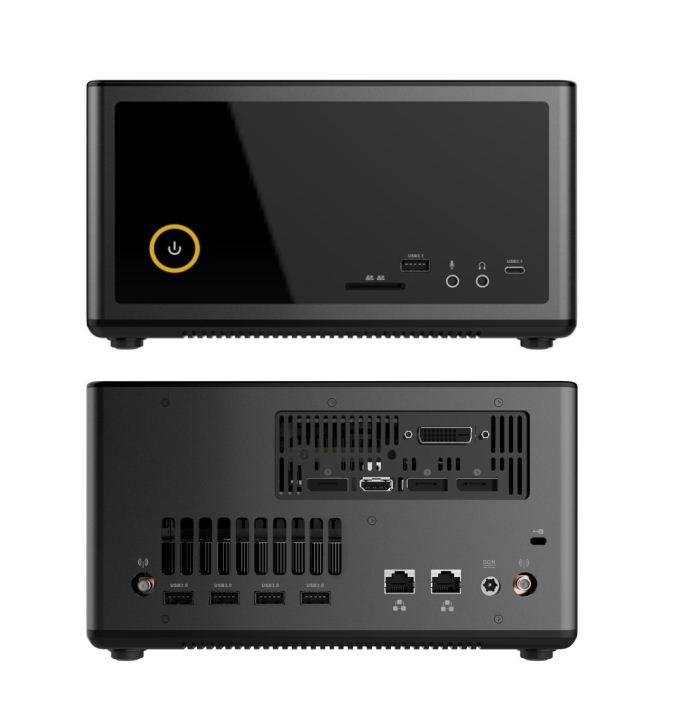Zotac ZBOX MAGNUS EK71080 Compact Gaming PC Review
by Ganesh T S on March 28, 2018 8:00 AM ESTConcluding Remarks
The preceding pages have shown that the Zotac ZBOX MAGNUS EK71080 delivers great performance with a compact footprint. With the Core i7-7700HQ, it can perform as well as any flagship mainstream gaming notebook from a CPU-centric viewpoint. On the GPU side, the GTX 1080 is one of the highest-end GPUs that is available for integration in a small form-factor machine. Performance wise, the EK71080 should be able to tick all the boxes. The real clincher is that the barebones pricing is a good $400 cheaper than the launch price of the EN1080K. It is clear that Zotac's EN1080K is competing against desktop PCs from boutique PC vendors, but, the EK71080 is hoping to target a market segment with higher volume.
There are a number of tradeoffs that Zotac has made to bring down the price by $400 compared to the EN1080K:
- The replacement of liquid cooling with a fully air-cooled solution brings about its own pros and cons:
- The EK71080 is considerably lighter compared to the EN1080K, making it easier to carry around for LAN parties and other such scenarios.
- The noise profile, though not obnoxious, does turn out to be annoying.
- The updated cooling solution ensures that the GPU no longer needs to be a MXM card to fit in the same form factor. The discrete card connected via a riser may allow Zotac to create product updates and variants easily. It must be noted that any GPU change by the end-user voids the warranty.
- The use of a lower TDP CPU (45W Core i7-7700HQ) in the EK71080 compared to the 65W Core i7-7700 in the EN1080K also has its share of plus and minus points:
- The lower TDP CPU has allowed Zotac to replace the dual power brick solution with a single 330W adapter, ensuring easier portability compared to the EN1080K.
- In almost all tested workloads, the EK71080's Core i7-7700HQ could not match the performance of the Core i7-7700 in the EN1080K, as expected.
The only other complaint that I have against Zotac (in general, and not particularly against the EK71080) is the absence of an updated BIOS with the latest security patches even though significant time has passed since Intel released the fixed microcode for Kaby Lake systems. [ Update (April 5, 2018) : Zotac has now released a BIOS update for the EK71080 with the microcode patches integrated ]
Even though the EK71080 is a cost-down version of the EN1080K, some of our other feedback points from the EN1080K review still stand. A PCIe bridge for the SDXC slot instead of the USB 2.0 bridge (this can improve speeds with the latest UHS-II cards capable of operating at more than 150 MBps), and a 2x2 Wi-Fi radio (in fact, we are ready to sacrifice one of the two LAN ports for a 2x2 radio) would increase the appeal of the unit. It would also be nice to have a couple more USB 3.0 Type-A ports on the sides of the chassis, or, in the front panel. It would not be a bad idea to convert a couple of the USB 3.0 ports in the rear to USB 2.0 (as they probably get used for the keyboard and/or the mouse), while shifting the USB 3.0 ports to a more accessible place. We would also like Zotac to explore internal PSUs without incurring a significant penalty in the chassis size.
We would also like to see the SGX support firmed up (the BIOS option was a welcome surprise) and the ASM2142 USB 3.1 bridge replaced with a Thunderbolt 3 controller. Enabling support for the Intel integrated GPU (even in a headless configuration) would also be nice to have.
On the whole, the Zotac ZBOX MAGNUS EK71080 is able to successfully achieve Zotac's goal of making high-performance gaming SFF machines affordable. We would love to see Zotac iterate on this design and integrate our feedback into future high-performance products at a similar or lower price point. The liquid cooling solution in the EN1080K was quite effective. Zotac should continue to retain that for the premium line of products while adopting the air-cooled strategy for the ZBOX MAGNUS EK71080 and other PCs in that price range.












17 Comments
View All Comments
The_Assimilator - Wednesday, March 28, 2018 - link
Would be nice to see pictures of the graphics card and how it connects to the motherboard, HINT HINT.And... am I the only one who thinks this unit is oriented the wrong way up? That exploded diagram Zotac provided show the CPU and graphics card drawing cool air in from the top of the case - but as we know, hot air rises, so what's gonna happen (to my thinking at least) is that the hot exhaust air is going to rise and get pulled back into the system, and go round and round and round...
Surely the cooling would work better if the unit was upside down, allowing the CPU and GPU to pull in cool air from the bottom and exhaust it higher up so it can rise? I'm assuming Zotac tested this, but it would be fun for AnandTech to confirm whether I'm crazy or not.
JoeyJoJo123 - Wednesday, March 28, 2018 - link
Natural convection is such a weak force that it only matters for completely passively cooled systems. Forcibly exhausting warm air outside the case is a vastly stronger option for removing heat and the orientation of where it's directing heat (up, side, down, or whatever) has no bearing on the effective heat dissipation, regardless of whether it's in line with natural convection or the opposite direction, so long as the exhaust isn't being pointed in a direction that blocks the air (ex: single exhaust fan pointing downward on a midtower sitting 1" off the carpet floor, the exhaust won't be able to remove air since there is a barrier on the other side)Simply put, convection doesn't matter in PC systems with fan intakes/exhausts.
vailr - Wednesday, March 28, 2018 - link
Is that GTX 1080 a mobile or desktop GPU? How is it cooled?From the photos, it looks like some kind of custom desktop GPU type of card, with 1x DVI, 1x HDMI & 3x DP ports, with the GPU chip on the under side of the card (?). Which would be less effective as a cooling solution, compared with the GPU and it's cooling fan on the top side: heat rises.
ganeshts - Wednesday, March 28, 2018 - link
It is a desktop GPU configured with a 175W TDP (as evident from the power component in the thermal stress section).I don't believe this is a custom card, just the ZOTAC GeForce GTX 1080 Mini with a different fan configuration. The display outputs at the back match exactly with the card used in the EK71080.
guidryp - Saturday, March 31, 2018 - link
Do you guys not have a PC with desktop GPU to provide at least one such comparison.It would be useful to know, how much performance you are giving for the tiny form factor.
Hixbot - Wednesday, April 4, 2018 - link
I really think noise levels should be compared in all these SFF reviews.modport - Friday, April 6, 2018 - link
I'm looking into pre-built more minimal looking (to put it nicely) gaming mini PCs. Noise level is definitely a factor. It'd be nice to compare actual dBA levels.rima1 - Friday, April 6, 2018 - link
Uncommon work! Each and every one of you finish a stunning web journal, and have some exceptional substance. Continue doing dazzlinghttp://carmelflowers.net/
keralataxi - Thursday, May 31, 2018 - link
The details about power your play is new to us.I am so thankful to you for added my knowledge.http://keralatravelcabs.com/tempo-traveller-taxi-s...
bestessay1 - Friday, April 6, 2018 - link
All I can express that I genuinely savored the experience of breaking down this stunning post.http://myessaypapers.net